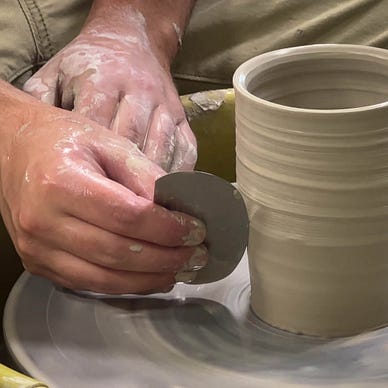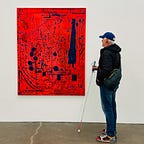My Top Suggestion For Becoming a Better Photographer
Take an art class, ANY art class
The new school year has arrived, and once again, I’m diving into art classes in areas where I have little to no experience. For those unfamiliar with my journey, I returned to school in May 2023 to pursue a BFA in Studio Art with a concentration in Film Photography. I’ve been chronicling this experience through a series of articles here on Medium.



This fall, I’m going back to basics with foundations classes in 2D Design and Drawing 1. So far, I’ve completed courses in Ceramics, Color Theory, two painting classes, and an Advanced Ideas and Concepts class. Although my concentration is in Film Photography, you might notice that I haven’t taken a single photography class yet. Despite this, every course I’ve taken has helped me develop skills that have ultimately made me a better photographer.
This leads me to the premise for this article: my belief that the best thing you can do to make yourself a better photographer is to take an art class, ANY art class. Based on my experiences in art school in the last 16 months, in this article, I’ll share the critical aspects of my learning experience that are helping make me a better photographer. Everything I’ll share aligns with one concept: the more I learn about making art, the more creative I become, and the more creative I become, the better my photography will be.
You can’t use up creativity. The more you use, the more you have.
— Maya Angelou
Learning to See/Strengthening Your Visual Skills
Honing the skill of genuinely seeing has been a consistent theme across all my classes, forming the basis of countless exercises and assignments. As photographers, we often pride ourselves on our observational skills, believing them to be the cornerstone of our craft. However, as I’ve ventured into new disciplines like drawing, painting, and design, I’ve come to understand a subtle yet profound distinction. As a photographer, I’ve trained myself more to compose than to see. This difference lies in the tendency to search for a pre-existing composition rather than to observe and interpret the world around me with fresh eyes.
In art school, I’ve learned to look for shape, color, and color relationships, line, rhythm, balance, contrast, and harmony, among many other elements. Although all these elements of composition are also essential in photography, my photographer’s eye tends to look at them as a whole rather than as a series of individual components.
Learning to see the world around me as elements of design and composition gives me the tools to create work when starting with a blank canvas, sheet of paper, or slab of clay. As a photographer, I have trained my eye to identify and frame great compositions. As an art student, I am learning how to imagine great compositions.
Learning From Critique
The critiques I experienced before going to art school were more like mutual appreciation experiences, where we all shared what we like about each other's work and maybe made a small and gentle suggestion like, “Had you thought of cropping it more tightly?”
The critiques I experience at school are more like getting graded in public, where you learn, in front of other students, whether what you are making is working or not. It’s where you explain your choices and your vision for your piece. It can be a humbling experience, although it’s one of the most essential tools for growing as an artist.
Although having your work dissected by others in a public setting can be challenging — no matter how kind and gentle the critique — it’s an experience many creatives don’t encounter often enough. Critique sessions provide a unique opportunity to articulate your creative decisions and gain insights into how others perceive and interpret your work. They are essential for growth, as they teach you to toughen up while staying open to constructive feedback, ultimately helping you refine your craft and broaden your perspective.
The Value of Assignments
I have a love/hate relationship with my school assignments. Like taking your medicine, I know they are good for my artistic growth, but they can also challenge my artistic insecurities. These insecurities can be particularly strong in drawing and painting assignments in classes where I am surrounded by a room full of “art kids” with serious drawing and painting chops. My lack of drawing and painting skills, coupled with my visual disability, often lead me to struggle through the assignments.
Taking on learning assignments is certainly familiar to me. As a photographer who is continually trying to improve my practice, I mainly use tutorials at the University of YouTube. However, I move quickly through those YouTube tutorials if I don’t find them especially engaging, and I often abandon them halfway through. At school, abandoning assignments is just not an option.
Did I want to spend those many hours creating a complex collage on the top half of a sheet of 19 1/2 x14 paper and then recreate that same collage below using gouache paint? Heck No! Did I learn a tremendous amount about creating a composition with a strong tonal balance and then learn to master the challenging art of color matching? Heck yes!
The many and varied assignments I take on at school push me in ways that often make me uncomfortable. This is most often the case when those assignments push on my artistic weaknesses. But pushing through your areas of weakness is where the growth comes from, both artistically and personally. Years from now, will I show the work I created in school? Likely not, but will the work I make in school drive the direction of my future work? Absolutely.
Learning From /Being Inspired By The Work of Other Students
As mentioned, I am surrounded by many “art kids” with serious chops. While I expected to be surrounded by talent, I did not expect how much the talent of my fellow students would inspire me and help me grow as an artist. As photographers, we appreciate and learn from the work of other photographers we admire. Still, it’s a different experience when you see how your fellow students respond to the same assignment or prompt you are working from.
Working alone as artists, we can get stuck seeing the world only through our own artistic choices, often not realizing there are a multitude of ways to approach our artwork. It’s a fantastic experience to see the varied number of approaches a class can take to the same prompt. I cannot tell you the number of times I said, “I never thought of that,” to my classmates.
Being surrounded by talented classmates has opened my eyes to new ways of approaching an artistic challenge and pushed me to work harder and become a better artist. It’s like being a member of a team of athletes who are faster/more skilled than you—it drives you to elevate your own game.
Tips for Finding Low-cost Classes
Hopefully, this article has inspired you to consider taking an art class, but it raises the question of where to go and how much it will cost. If you are like me and are older, the good news is that here in the U.S., classes at state universities and colleges are often free for older students. But for those of you who are younger, many states allow residents free access to courses at state learning institutions, although without earning credits.
Additionally, most towns and cities have local art centers or continuing education programs that offer many inexpensive art classes. I’m guessing there are affordable or free options for many of you reading this article.
Here are a few ideas and links to get you started:
Local Community Colleges and Adult Education Programs:
Community Colleges: Many community colleges offer affordable art classes, often with a focus on practical skills and techniques.
Adult Education Centers:
These centers frequently provide art classes tailored to adults, often at low cost or even free.
Museums and Art Centers:
Workshops and Classes: Many museums and art centers offer workshops and classes taught by professional artists. These can provide a unique, hands-on learning experience.
- Free (or Cheap) College for Seniors and Retirees in All 50 States
- 24 Colleges With Free Tuition for Senior Citizens
One Final Caveat
I strongly recommend taking an in-person art course. Although online classes may be more convenient and inexpensive, I believe there’s no substitute for in-person learning when studying art. From the ability to watch other students' work to experiencing others' artwork firsthand in a critique setting, in-person art classes are the way to go if at all possible.
Share Your Experience
Have you ever considered taking an art class? I’m curious to hear about your experiences with art education, especially if you’re a photographer or another type of artist. Please feel free to share any insights you may have, or ask questions if you’re interested in exploring art classes yourself.
All photos in this article are by Lawrence Lazare.
Explore the world of photography, art, and creativity with the writers of Live View.
